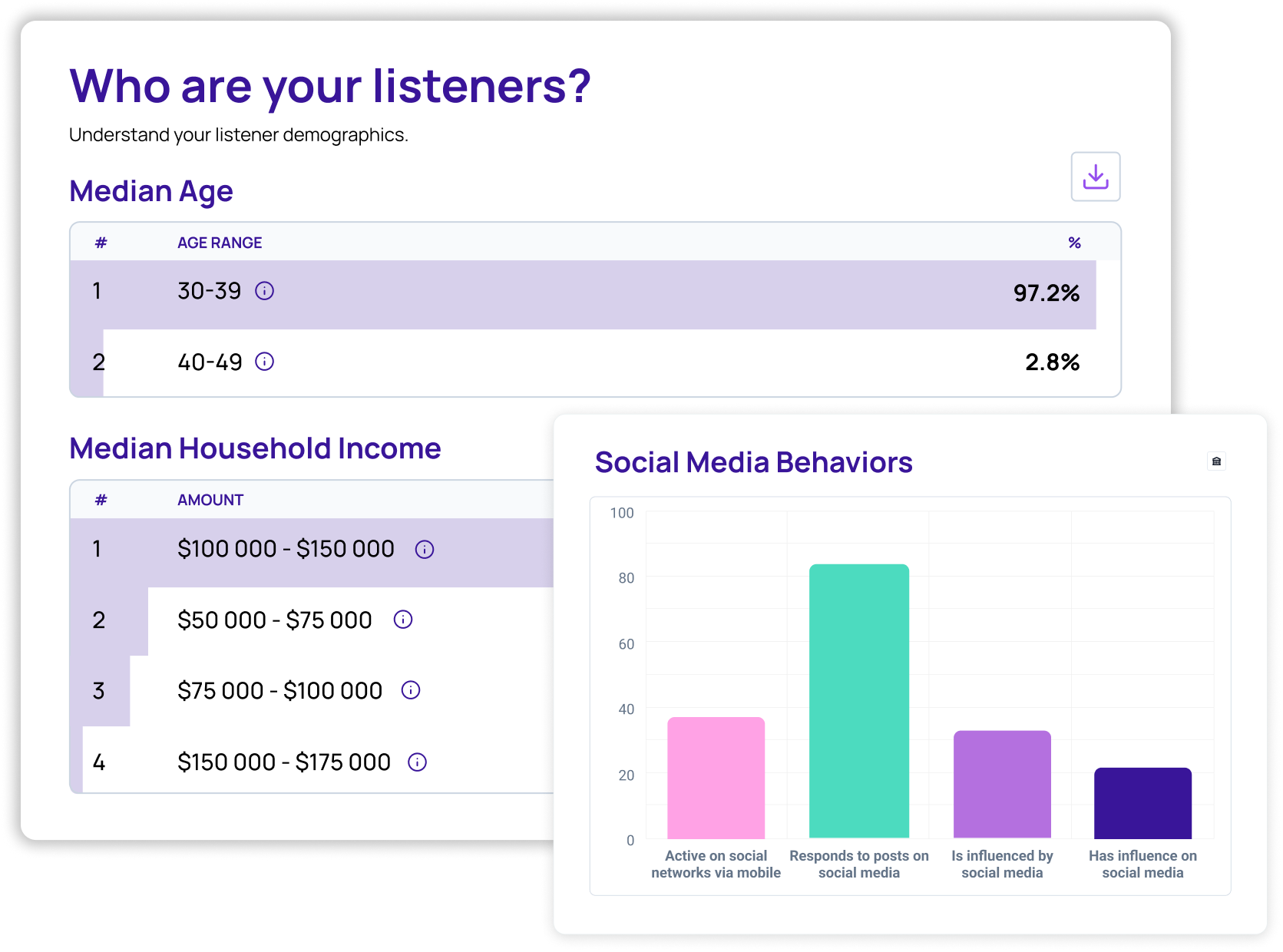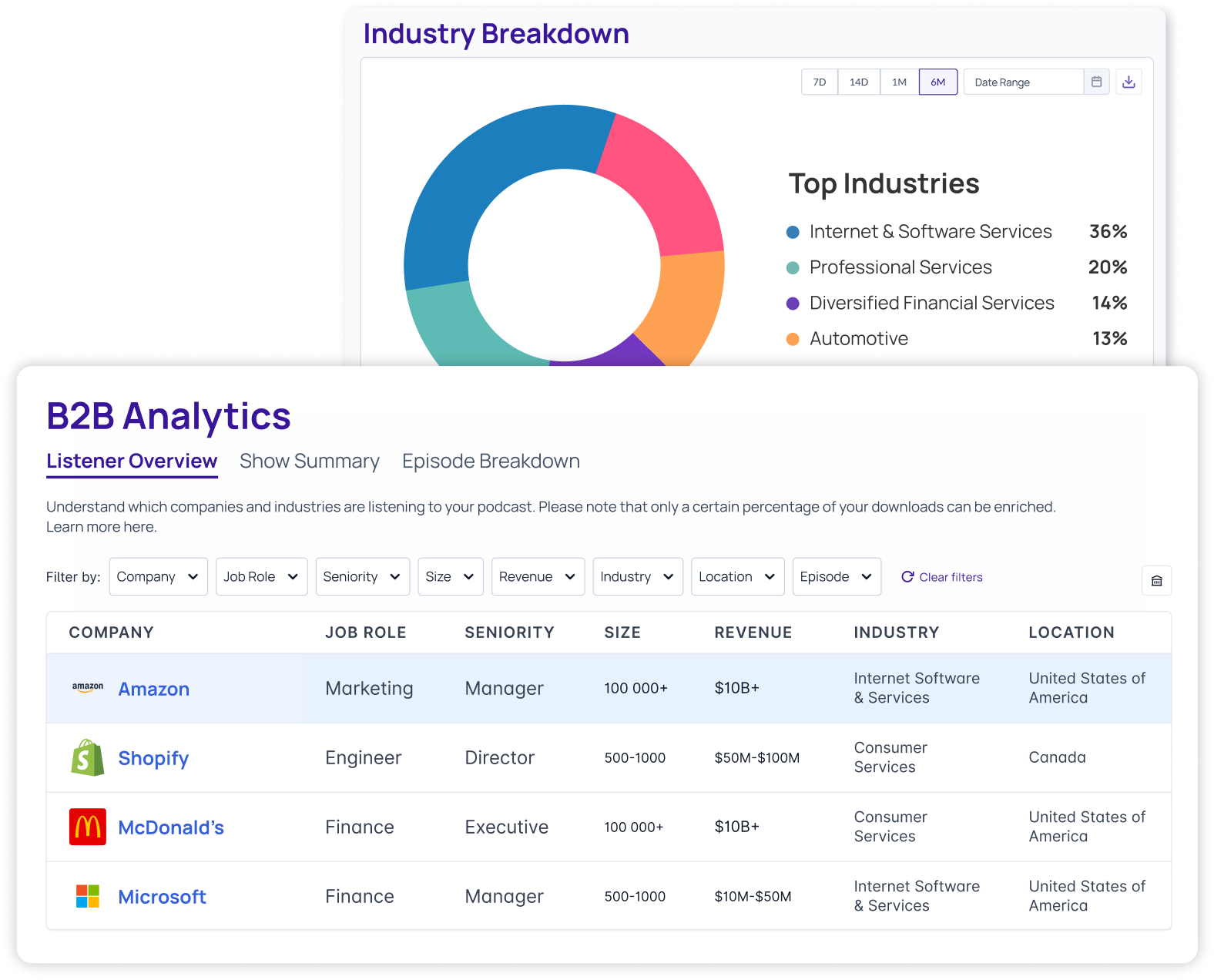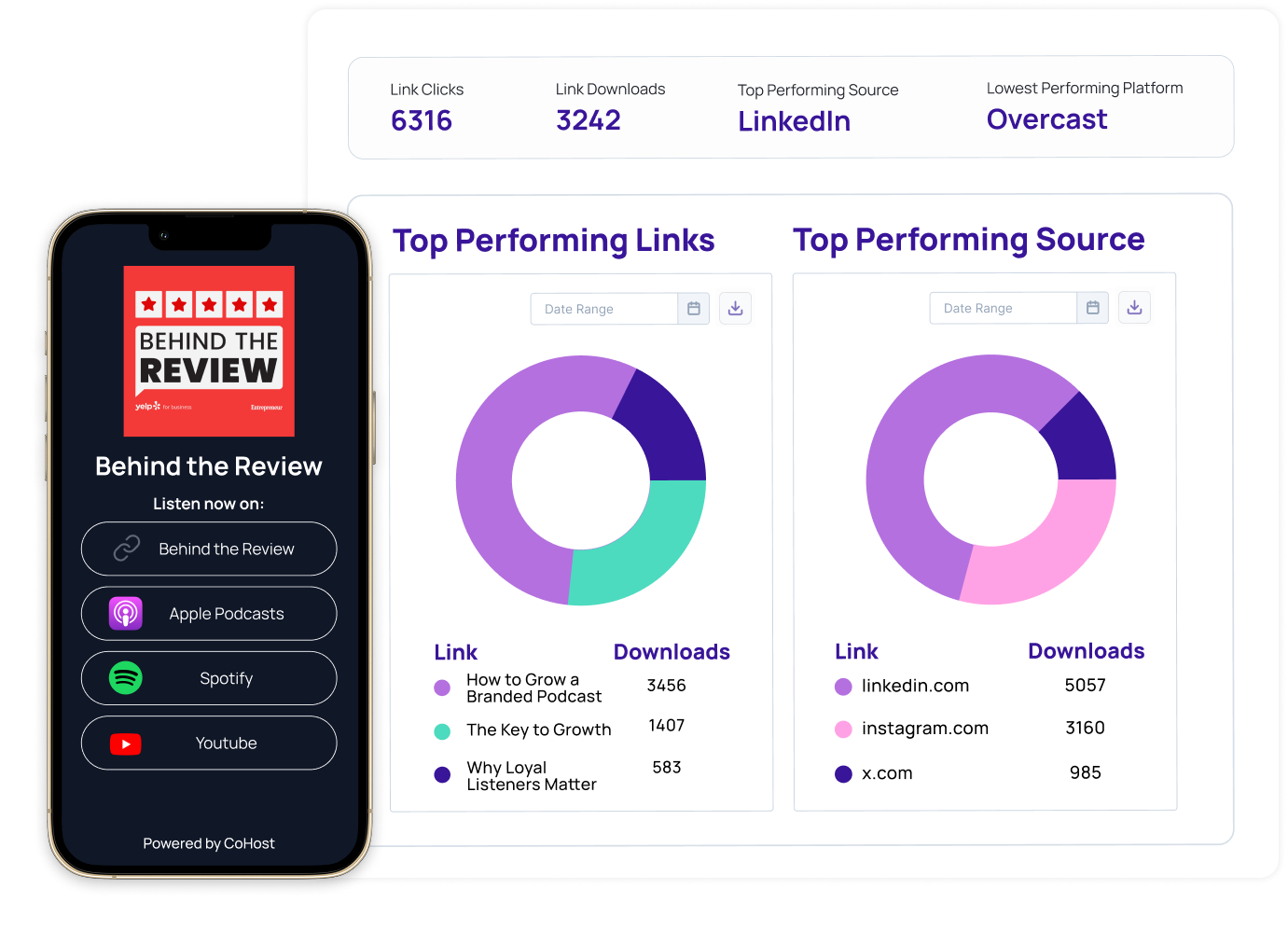Don’t we all wish a branded podcast was as easy as setting up a microphone, hitting record, and pushing the episode out to your audience who’s patiently waiting?
Yes, yes, we do.
But is that the reality? No, no, it is not.
Since you’re reading this article, I’m going to assume you have some experience within the podcast industry. Whether that’s working on one for your company, a client, or as a hobby. And you’ve likely seen discord around the need for a robust audience growth strategy, creative content, and of course, podcast analytics.
Leveraging podcast analytics can be the difference between stagnant downloads and audience growth that truly moves the needle.
In this blog, we’re breaking down the analytics that matter most and how you can use them to shape smarter content strategies, reach the right listeners, and create podcasts that grow.
Because we’re not here to just track the metrics, we’re going to actually use them to guide our podcast. So, let’s get into it:
TL;DR: Podcast analytics to power your growth strategy
- Track the right metrics: Downloads and unique listeners help you monitor growth, but go deeper with consumption, engagement, and listener retention data.
- Understand your audience: Demographics, psychographics, and firmographics tell you who your listeners are—and how to tailor content that resonates.
- Use tracking links: Identify which channels and campaigns actually drive listens so you can double down on what works (and ditch what doesn’t).
- Measure smarter KPIs: Cost per listener attention gives you a more accurate view of ROI than cost per download.
- Let analytics guide strategy: From content planning to promotion, the smartest shows use data to inform decisions, optimize performance, and grow faster.
Why podcast analytics (really) matter
Let’s start with the obvious: You can’t improve what you don’t measure.
Podcast analytics give you insight into who’s listening, how they’re engaging, and what content resonates most. Without this, you’re relying on guesswork.
And in today’s saturated podcast market of 4.6 million shows, guesswork is a risky strategy:
- For marketers and creators, this means making informed, data-driven decisions about content themes, guest selection, episode length, and more.
- For agencies, analytics are your fuel for strategic recommendations, creative pivots, ROI reporting, and justifying budgets.
So today, we’re going to turn you into podcast data storytellers. We’ll equip you with the know-how to pull insights from your content and action them with a data-driven mindset.
1. Start with the basics: Unique listeners & downloads
At a glance, unique listeners and downloads help you gauge overall reach. While not the most nuanced metric, tracking growth here over time gives you an early indicator of whether your podcast is gaining traction.
.png)
Let’s take a closer look:
- Downloads: You might’ve heard people refer to downloads as “vanity metrics.” And I’d have to agree. Downloads don’t really tell you much aside from how many plans your podcast received. Similar to visitors on your website, you’re left with more questions than what this metric answers. But still, it’s a useful metric to track overall growth and awareness.
- Unique Listeners: My favorite of the two, unique listeners tell you how many individuals listened to your podcast. It’s more indicative of the true size of your audience as well as benchmarking recurring listeners. For example, you can start tracking episode over episode how many unique listeners you have. Once you find the pattern, e.g., you usually have at least 300 unique listeners every episode, you can safely assume that those 300 listeners are your recurring, loyal fans.
How to use it in your content strategy:
- Downloads: Watch for trends across new episode drops or season launches. If new episodes don’t move the needle, it could signal weak titles, unengaging topics, or poor promotional timing. Test tweaks and compare results.
- Unique Listeners: Track the numbers episode over episode to benchmark how many recurring or “loyal listeners” your show has. This gives you a better understanding of your true reach and audience size.
2. Dive deeper: Consumption & engagement metrics
If downloads tell you how many people started, engagement metrics tell you who stayed.
This data informs you how much of your content listeners are consuming, a key metric in performance measurement.
Why, you ask? Well, if you know where you’re losing listeners throughout episodes, you can start working towards retaining them for longer. Typically, we recommend aiming for a consumption rate between 75-80%.
*screenshot of consumption dashboard*
Engagement metrics include:
- Episode Consumption Rate: The percentage of an episode that was listened to.
- Show Consumption Rate: A snapshot of the average percentage of the show that is listened to.
- Average Listen Time: The average total time your episode is consumed for, in minutes.
These are your audience's way of saying, "This is interesting" or "You lost me halfway through."
How to use it in your content strategy:
- Identify patterns in episodes with high consumption rates or listen times: Were episodes shorter? Did they feature a particular guest? Did they tackle a trending topic? Use this insight to guide future content decisions.
- Review episodes with low consumption rates or listen rates: Where were listeners dropping off? Is there something that didn’t resonate with them? Are episodes too long? Is the topic not interesting to my audience?
- Compare content topics that resonate: Review consumption rates for episodes covering different topics. The ones with high consumption rates signal more resonance with audiences; whereas, the ones with low consumption rates signal the content isn’t of interest.
3. Know your audience: Demographics, psychographics & firmographics
It’s not just about how many people are listening—it’s who they are. Because if you don’t know who your audience is, how will you know the content they enjoy, how to market to them, or the guests they want to hear from?
Knowing who your listener is, especially for branded podcasts, is arguably the most important data to be tracking to understand if you’re reaching your desired target audience. So let’s break it down:

With podcast demographic and psychographic data, you can uncover listener:
- Age ranges
- Listening location (geographic breakdowns, typically by country, city, and state)
- Income
- Family makeup
- Lifestyle
- Interests & hobbies
- Social media consumption
- Social media habits

And with firmographic data, you can go even deeper:
- Companies where your listeners work
- Industry
- Company size
- Company location
- Company average revenue
- Listener job role at their company
- Listener job seniority at their company
How to use it in your content strategy:
- Compare your actual audience with your intended audience: Are you attracting who you thought you would? If not, either adjust your content or re-evaluate your target listener profile.
- Identify potential leads, sponsors, or partners: Through firmographic data, uncover potential business leads, podcast sponsors, or company partners by knowing the companies tuning in.
- Hyper-personalize your intros, CTAs, or series themes: Firmographic insights (like industry, job function, or company size) let you speak directly to your ideal listener. For example, if a large portion of your audience works in marketing at mid-size tech firms, open your episode by referencing a challenge they face or build a mini-series around solutions tailored to that niche.
- Spot gaps in your guest or topic lineup. Use demographic and psychographic data to identify underrepresented audience segments in your current content. If your listenership skews heavily toward a certain age group or interest, consider inviting guests or exploring topics that would appeal to these segments.
4. Attribution in action: Tracking link analytics
Tracking links are your best friend when it comes to proving ROI and understanding listener behavior across platforms.
By tracking click-to-downloads from marketing channels, you can see not only where your audience lives, but also which promotional campaigns are worth the investment and which ones to leave behind.

Podcast tracking links allow you to see:
- Where listener traffic is coming from
- Which platforms are converting listeners best
- What promotional tactics are not driving listens (and therefore, should be sunsetted)
- What promotional tactics are driving listens (e.g., newsletter vs. LinkedIn vs. paid media)
How to use it in your content strategy:
- Create unique tracking links for each campaign or channel: This will help you optimize your promotional strategy and understand which platforms bring in the most high-value listeners.
- Double down on the channels and campaigns that convert: If LinkedIn consistently drives high-value listeners, prioritize it with tailored creative and more consistent posting.
- Save time on channels and campaigns that don’t convert: If you see that X is never bringing listeners to the podcast, save the headache and invest your time in the channels that are.
- A/B test podcast content. Use tracking links to test campaigns, episode titles, headlines, content, and visuals, and let results steer your content promotion.
5. Cost per listener attention: A smarter KPI for brands
Forget cost per download. With podcasting, it’s not about who clicks play—it’s about who sticks around.
Cost per listener attention measures how much it costs to generate one minute of attention from a unique listener. It gives you a more accurate sense of engagement and ROI than top-of-funnel metrics.
The equation looks like this:
Cost of Listener Attention (CLA) = (Total Cost of Production + Marketing Spend) / Total Minutes Consumed by Listeners
You can also flip the equation to:
Total Minutes Consumed by Listeners / (Total Cost of Production + Marketing Spend) = Listener Attention Efficiency.
Listener Attention Efficiency tells you how many minutes of listener attention you’re earning per dollar spent, rather than CLA, which is how much you’re paying per minute of attention.
How to use it in your content strategy:
- Evaluating campaign performance. When evaluating campaign success, look at which episodes drive the most minutes listened per dollar spent. Use those insights to replicate the tone, theme, or format in future content. Prioritize the shows and moments that hook listeners deeply.
- Get a full picture of podcast success. Pair this with your average listen time and consumption rate to get a full picture of podcast performance. This is especially powerful when reporting up to stakeholders who want to understand podcast ROI.
How to use podcast analytics to shape content strategy
Now let’s bring it all together.
Within your content strategy, use podcast analytics to:
- Refine topics: See which themes consistently perform well and which fall flat.
- Tailor formats: Are shorter episodes more popular? Do interviews outperform solo episodes? Let the data decide.
- Schedule strategically: Analyze drop-off points and experiment with episode length or release cadence.
- Personalize guest selection: If certain guest types or industries perform better, prioritize them in future recordings.
- Repurpose with purpose: Use your top-performing content as the basis for social clips, blog posts, and paid campaigns.
Where to find podcast analytics & insights
Not all podcast analytics tools are created equal—and if you’re relying solely on what Apple and Spotify provide, you’re missing (at least) half the picture.
To truly understand your audience and make smarter content decisions, you need analytics that go beyond vanity metrics. That’s where podcast analytics and audience insights platforms like CoHost come in. And trust us, we’re only pitching ourselves here because we know the data we provide can help you.
CoHost equips you with:
- Cross-platform data: No more manually stitching together insights from multiple apps; get a consolidated view of your podcast data.
- Audience demographics & psychographics: Get a full listener profile of your audience from income and age to hobbies and social media consumption.
- B2B analytics & firmographics: See the companies, industries, and employee job roles and seniorities tuning in.
- Engagement metrics: Explore show consumption rate, episode consumption rate (Apple & Spotify), and listen time (Apple & Spotify).
- Tracking links & link analytics: Through a LinkTree-style page, track click-to-downloads to uncover the channels that drive listeners.
Great content starts with knowing what’s working (and what’s not).
So, whether you're a brand looking to validate ROI or an agency reporting back to clients, CoHost gives you the insights you need to not only track performance—but actually shape strategy.
Better data, better podcasts
Podcast analytics aren’t just dashboards; they’re decision-making tools.
And when used well, they become the foundation for a content strategy that actually drives results.
At CoHost, we believe podcasting should be as data-driven as every other marketing channel. Not because we love numbers (though we do), but because we know that behind every metric is a listener and understanding them is how you grow.
Want to learn more about how to use data to fuel your podcast strategy? Explore CoHost's analytics tools and subscribe to Tuned In, our bi-weekly newsletter for brands and agencies looking to build smarter, more impactful podcasts.










